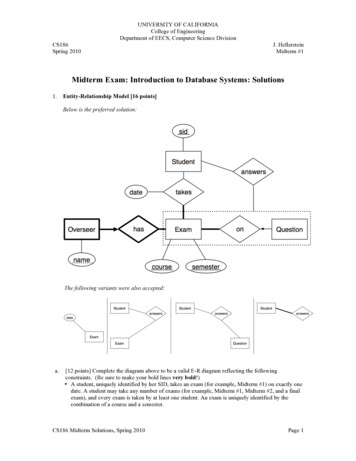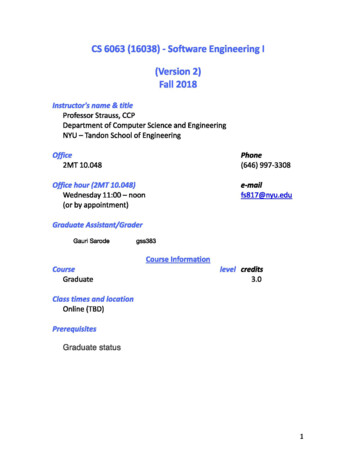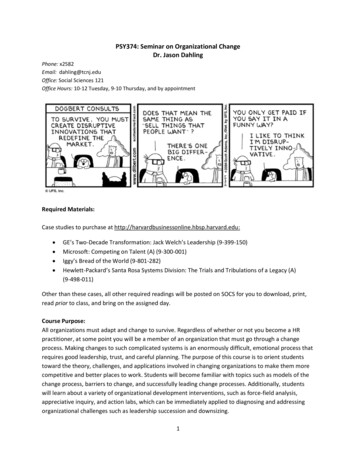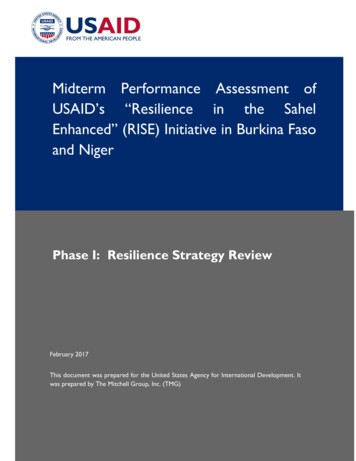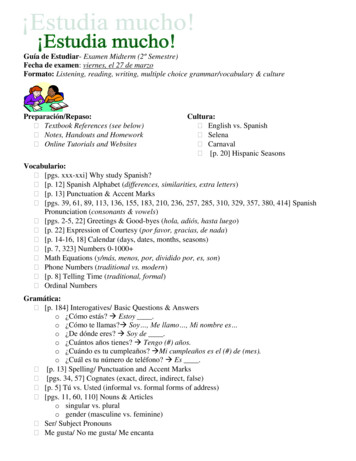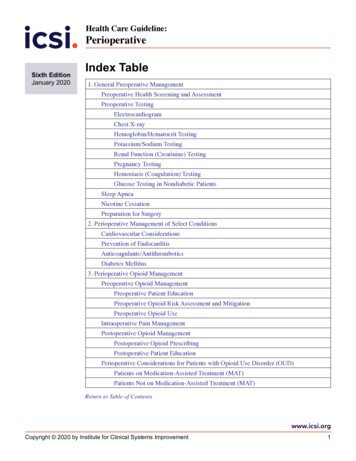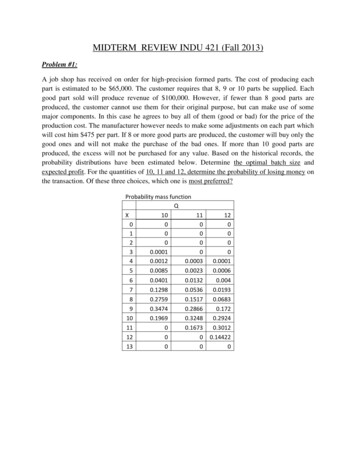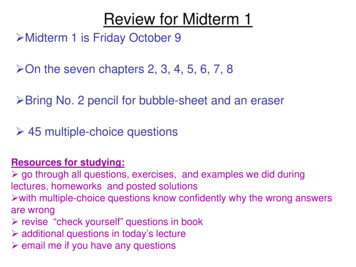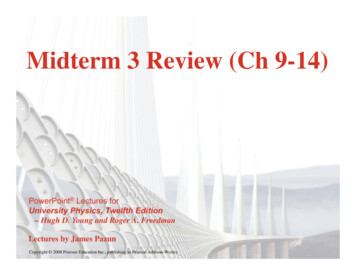
Transcription
Midterm 3 Review (Ch 9-14)PowerPoint Lectures forUniversity Physics, Twelfth Edition– Hugh D. Young and Roger A. FreedmanLectures by James PazunCopyright 2008 Pearson Education Inc., publishing as Pearson Addison-Wesley
Ch 9 Overview: Rotational Motion– Position – Velocity – Acceleration – Force – Mass – Momentum – Energy Chapters 4-7 Chapters 1-3 Take our results from “linear” physics and do the samefor “angular” physics Analogue of
Ch 9: Rotational KinematicsKinematic equation just like before:θ like displacement xω like velocity vα like acceleration aRelation between linear quantities and angular quantities (by geometry)l R v tan l R tatan v tan R taradv 2 tan R 2RKinetic energy of a rotating object about a fixed (stationary) axis:KE rot1 2 I 2I mi ri1 21KE mv cm Icm 2222Moment of inertia or “angular mass”(DEPENDS ON THE AXIS CHOSEN)iSum of translational and rotational energies
Rolling without Slipping In reality, car tires both rotate andtranslate They are a good example ofsomething which rolls (translates,moves forward, rotates) withoutslipping Is there friction? What kind?SM Flag: 30%Relation between translational androtational velocities in no slip condition
A Rolling Wheel A wheel rolls on the surfacewithout slipping with velocityV (your speedometer) What is the velocity of thecenter of the wheel (point C)? What is the velocity of thelowest point (point P) w.r.t.the ground?– Does it make sense to you?
Try Differently: Paper Roll A paper towel unrollswith velocity V– Conceptually same thingas the wheel– What’s the velocity ofpoints:– A? B? C? D?BBA Point C is where rollingpart separates from theunrolled portionDCCA– Both have same velocitythere
Bicycle comes to RestA bicycle with initial linear velocity V0 deceleratesuniformly (without slipping) to rest over adistance d. For a wheel of radius R:a) What is the angular velocity at t0 0?b) Total revolutions before it stops?c) Total angular distance traversedby wheel?d) The angular acceleration?e) The total time until it stops?
An athlete throwing the discusA discus thrower moves the discus in a circle of radius 80.0 cm. At a certaininstant the thrower is spinning at an angular speed of 10.0 rad/s and the angularspeed is increasing at 50.0 rad/s2. At this instant find the acceleration of thediscus and its magnitudeatan r (0.800 m)(50.0 rad/s2 ) 40.0 m/s2arad r 2 (10.0 rad/s)2 (0.800 m) 80.0 m/s2a atan 2 arad 2 89.4 m/s2
Finding the moment of inertia for common shapes:Moment of Inertia will be provided for the exam
What is the velocity of the blockwhen it hits the ground?The work done by the cable is zerosince the two tension forces canceleach other out so energy is conservedKE i PE i KE f PE f110 mgh mv 2 I 2 0222 v1 2 1 10 mgh mv MR 2 0 R 22 22mghv (m M/2)
Rolling without slippingv cm R This is the condition to rollwithout slipping.Then, if you are rolling without slipping the kinetic energy isWhen rolling without slipping then1 211 2 1 Icm 22KE mv cm Icm mv cm v2222 R2Also note that when one is rolling without slipping (i.e. rolling down anincline) the friction force is static so no work is done by it and energy isconserved in this case.
Consider the speed of a yo-yo toyWhat is the speed of the Yo-yo at the bottom (use conservation of energy)Why conservation of energy: the hand is not moving so itdoes no work on the system. You may be confused aboutthe tension but keep in mind that it is an internal force sothe sum of the upper and lower tension is zero.Ei E f11Mv 2cm Icm 222 v cm 211 1220 Mgh Mv cm MR R 22 23Mgh Mv 2cm44 v cm gh30 Mgh
Ch 10: Rotational DynamicsTorque results from force applied at a distance from a pivot pointr r r r F rF sin The direction of the torqueis given by the RHR
Write Torque as r F sin r F To find the direction ofthe torque, wrap yourfingers in the directionthe torque makes theobject twist If the axis is fixed,what is the netTorque on the wheel?Torque
Torque and Moment of Inertia Force vs. TorqueF maand I Mass vs. Moment of Inertiam I mr2I r dm2or
Flywheel problem from Ch 9(using work energy theorem)The cable is wrapped around a cylinder. If it unwinds 2.0 m by pulling it with aforce of 9.0 N and it starts at rest, what is its final angular velocity andvelocity of the cable? (use work energy theorem)W total KE f KE i1F x I 2 022F x I4F x2 20 rad/smRv R (20 rad/s)(0.060 m) 1.2 m/s
Flywheel problem using torque(using work energy theorem)The cable is wrapped around a cylinder. If it unwinds 2.0 m by pulling it with aforce of 9.0 N and it starts at rest, what is its final angular velocity andvelocity of the cable? (use work energy theorem)1I MR 22 FR (9.0 N)(0.06 m) 2FR2F2 I 6.0rad/sI MR 2 MRUse α to get acceleration of the cable:atan R (0.06m)(6.0 rad/s2 ) 0.36 m/s2Then use kinematicsv 2 v 20 2atan (x x 0 )v 0 2(0.36 m/s2 )(2 m) 1.2 m/s
What is the velocity of the blockwhen it hits the ground?The work done by the cable is zerosince the two tension forces canceleach other out so energy is conservedKE i PE i KE f PE f110 mgh mv 2 I 2 0222 1 2 1 1v0 mgh mv MR 2 0 R 22 22mghv (m M/2)
Another look at the unwinding cableWhat is the linear acceleration of the block?These are two coupled objects; one rotatesand the other moves linearlyFor the rotating wheel we have: I 112 aTR MR T Ma R 22For the block we have:mg T maCombine the two equations to get1mg Ma ma2mg a m M /2SM Flag: 55%Connection between rotational andtranslational accln of coupled objects
SM Flag: 50%Angular momentumboth rxp and Iw
Conservation of angular momentumRecall that torque was defined asr r r r FSimilarly the angular momentum of a particle isr r r rrL r p r m vBefore we saw that if the external forces on a system are zero then linear momentumis conserved. Similar for angular momentum.If the external torques on a system are zero then theTOTAL angular momentum of the systems is conserved.Note that in this case the TORQUE has to be zero.There can be still forces acting on the system butthey do not generate any torque (e.g. force due togravity on the cat which acts at the center of mass)I1 1 I2 2
How a car’s clutch workThe clutch disk and the gear disk ispushed into each other by two forcesthat do not impart any torque, what is thefinal angular velocity when they cometogether?Lz before Lz afterIA A IB B (IA IB ) final finalI A A I B B (IA IB )
Ch 11: Conditions for equilibrium Net Force is zero (x,y,z) Net torque is zero.
Strategy F Fx 0y 0 01st Draw the free body diagram and the location where the forces are applied2nd Choose a Pivot Point which will delete the largest amount of torques3rd Compute the torques from each force4th Solve the equations
Problem 11.27The horizontal beam in the figure weighs 150 N, and its center of gravity is at itscenter. Find the tension in the cable and on the beam at the hinge.SM Flag: 30%Contact forces
Ch 13: Newton’s Law of Gravitation The gravitational forceis always attractive anddepends on both themasses of the bodiesinvolved and theirseparations.Gm1m2Fg r2G 6.6742 10 -11N m2kg 2
Weight (skip Weight Watchers, just climb upward) Gravity (and hence, weight) decreases as altitude rises.
Gravitational potential energy Objects changing their distance from earth are alsochanging their potential energy with respect to earth.m1m2PE Gr12This is the true potential energy. The zero level is setwhen they are very far apart
Satellite circular motionThe force is radial so Newton’s 2nd law reads:M E msv24 2 R m mssR2RT2M v G ERr: G T 4 2R 3GM ET R3/2SM Flag: 40%Gravitational forceprovides centripetal accln
Escaping from the EarthWhat is the velocity you need to shoot straight up from the surface of theearth an not come back (conservation of energy)?KE1 PE1 KE PE mM E1m v2 G 0 0RE2 v SM Flag: 40%Energy conservation2GM E 1.12 10 4 m/s 25,000 mphRE
Ch 14: Simple Harmonic Motion The spring drives the glider backand forth on the air-track and youcan observe the changes in thefree-body diagram as the motionproceeds from –A to A and back.The pendulum is another exampleElements of harmonic motion:Frequency: f 1/TAngular frequency: ω 2πfAmplitude: maximum deflection/stretch/compression
Simple harmonic motion An ideal springresponds to stretch andcompression linearly,obeying Hooke’s Law.Fx kxThe restoring force towards theequilibrium point is LINEAR from thedisplacement from equilibriumLet’s look at Newton’s 2nd law:d2xFx max kx max m 2dtd2xk 2 xmdtd2x 2 2 xdt
Watch variables change for a glider example As the glider undergoesSHM, you can trackchanges in velocity andacceleration as theposition changesbetween the turningpoints.x(t) Acos( t )v(t) Asin( t )a(t) A 2 cos( t )
Energy in SHM Energy is conserved during SHM and the forms(potential and kinetic) interconvert as the positionof the object in motion changes.1111E mv 2x kx 2 kA 2 mv 2max2222SM Flag: 37%Energy at different points
Energy in SHM II
The simple pendulumOk when Θ 1Ftan mgsin mg Ftan matand 2 mL 2dtd 2 mL 2 mg dtgd 2 dt 2L g1f L2 gLT 2 Lg
The physical pendulum A physical pendulumis any real pendulumthat uses anextended body inmotion. Thisillustrates a physicalpendulum.IT 2 mgd
instant the thrower is spinning at an angular speed of 10.0 rad/s and the angular speed is increasing at 50.0 rad/s2. At this instant find the acceleration of the discus and its magnitude a ta
